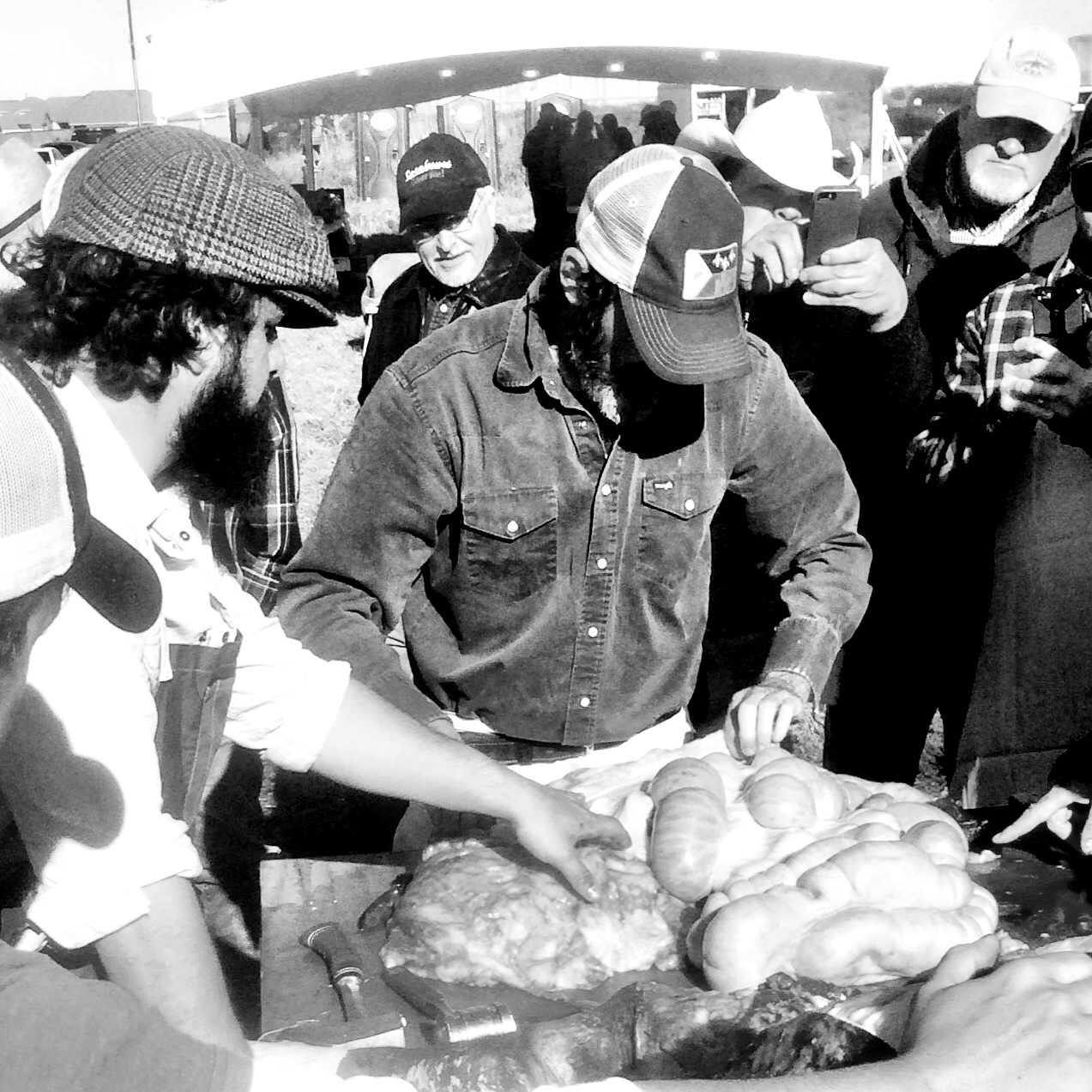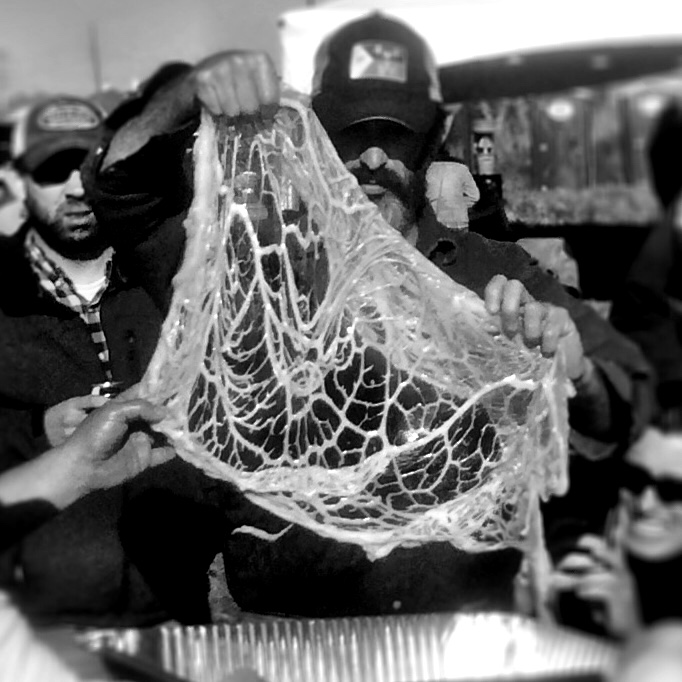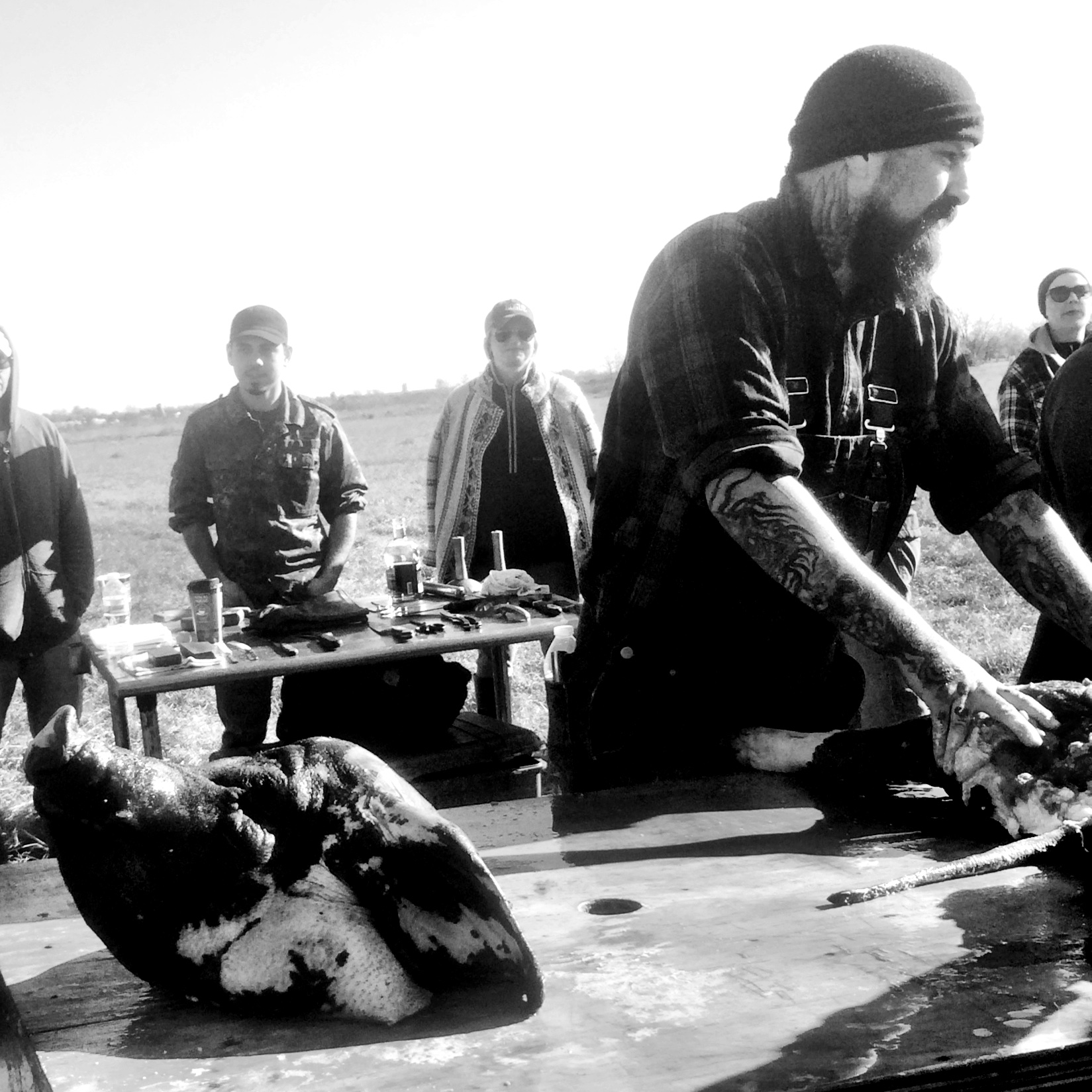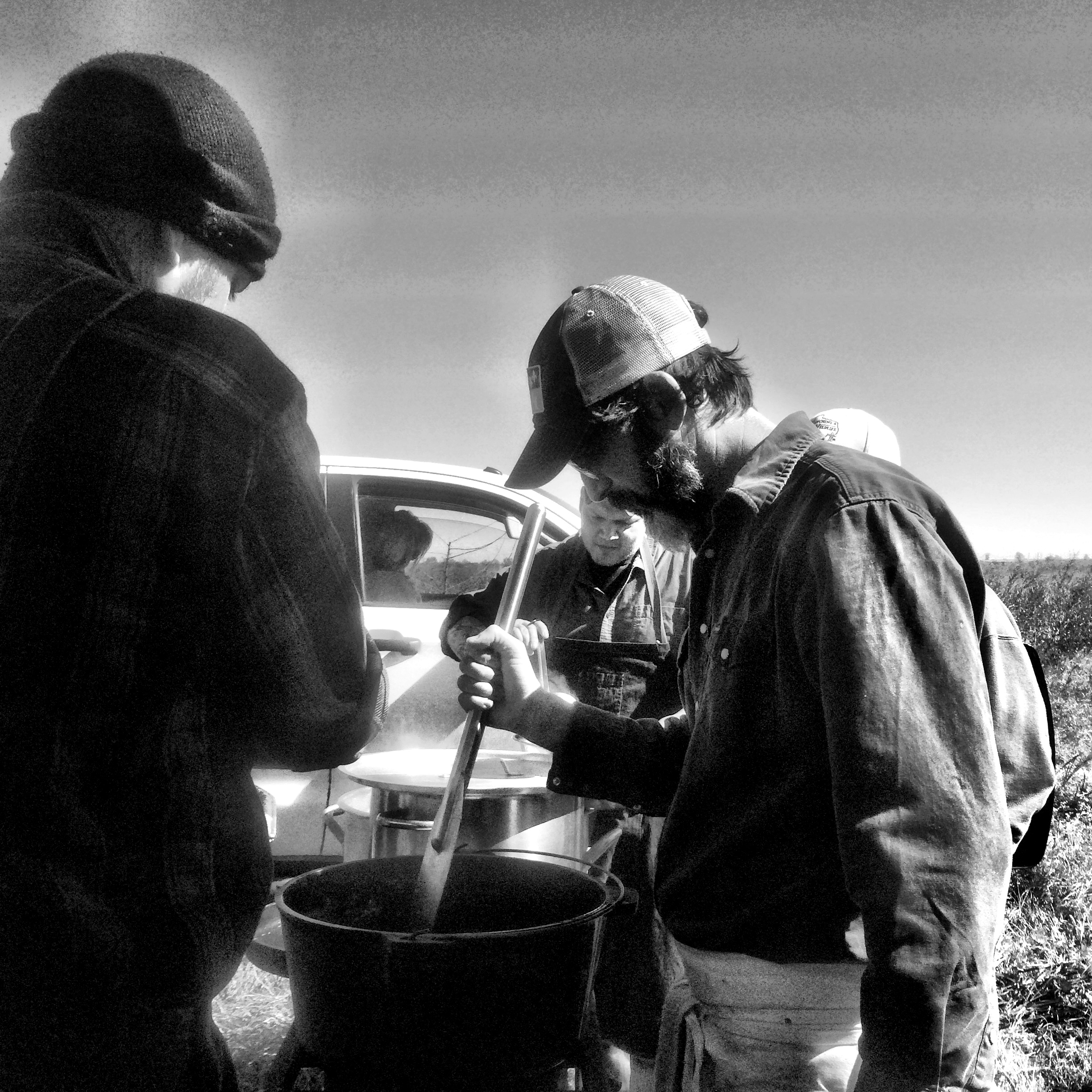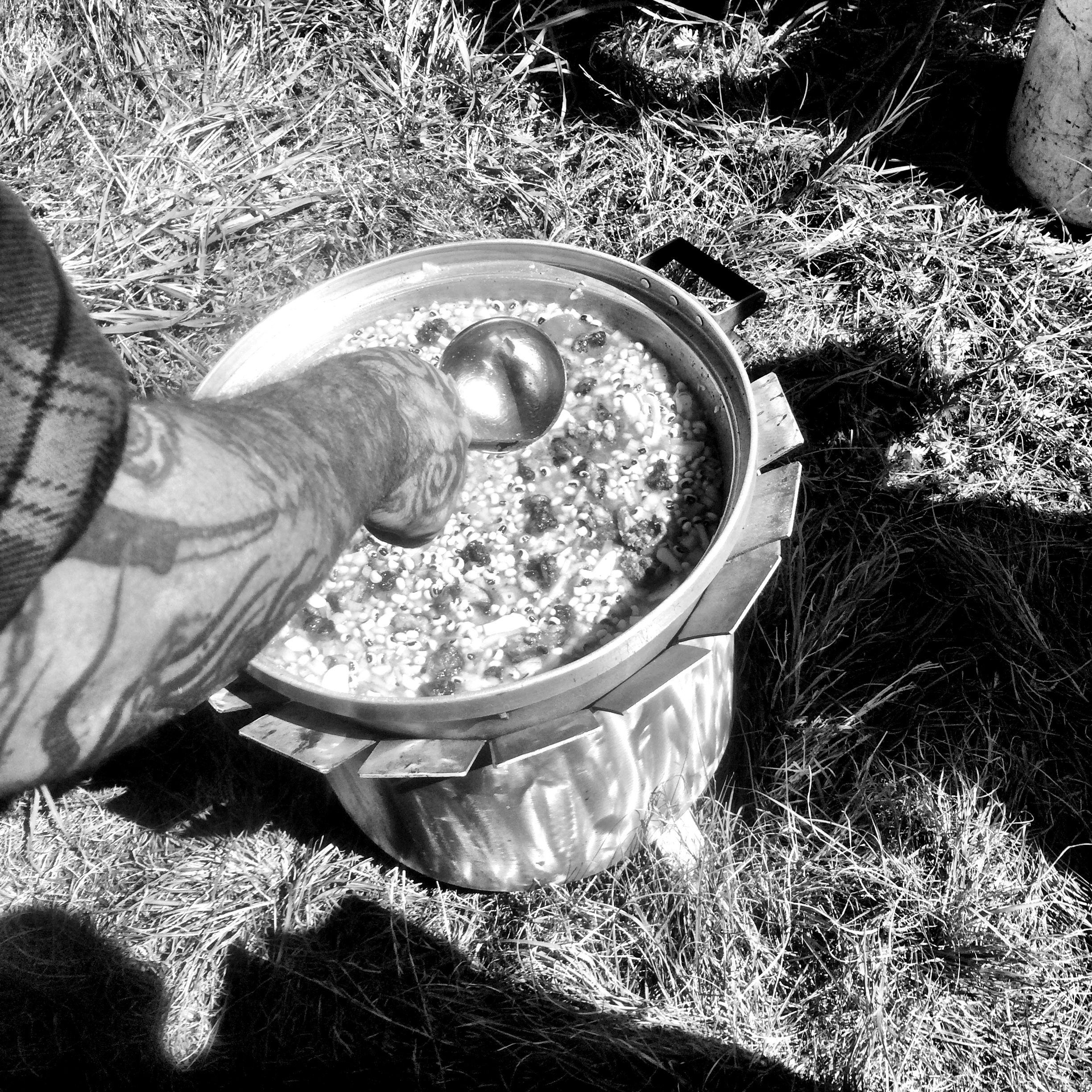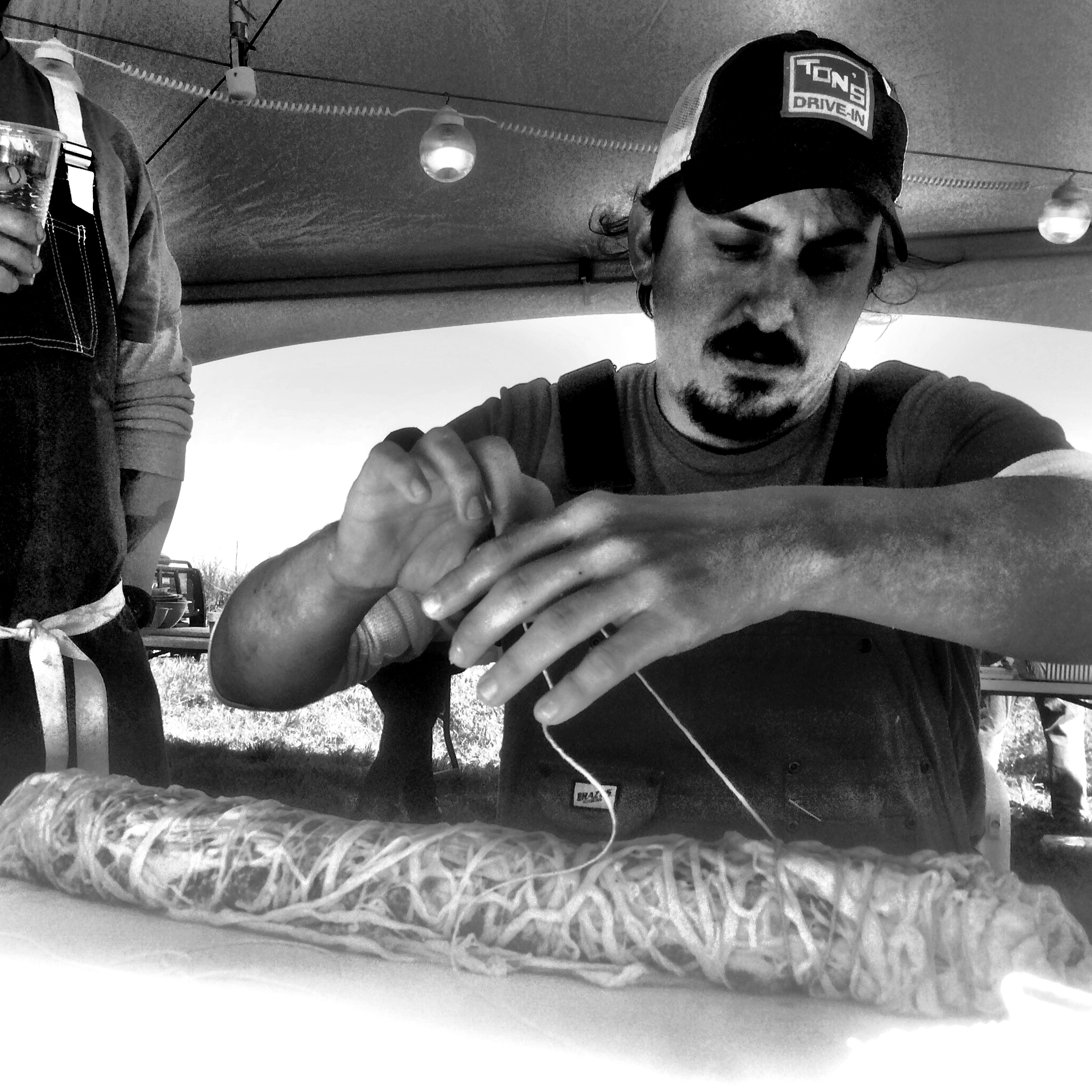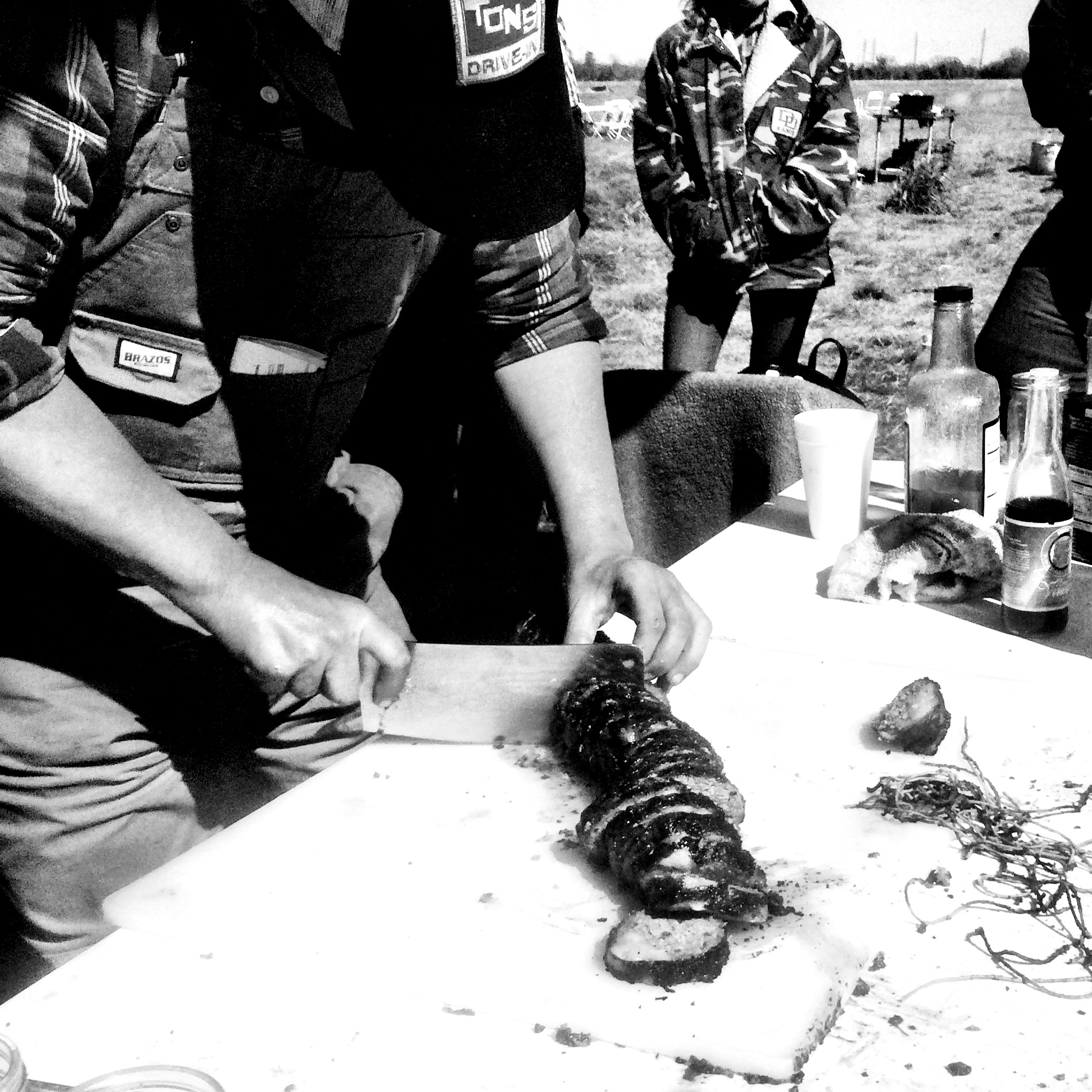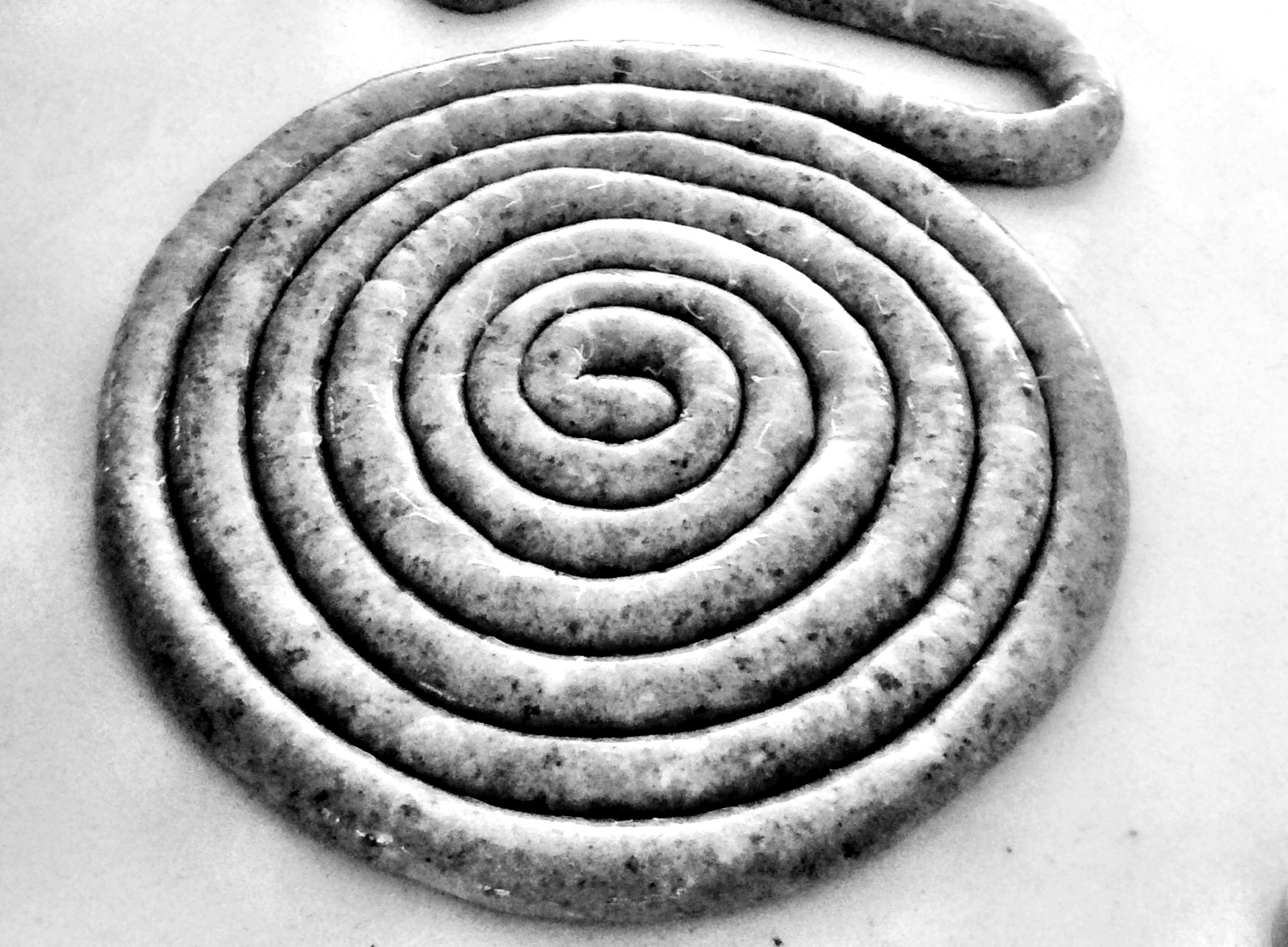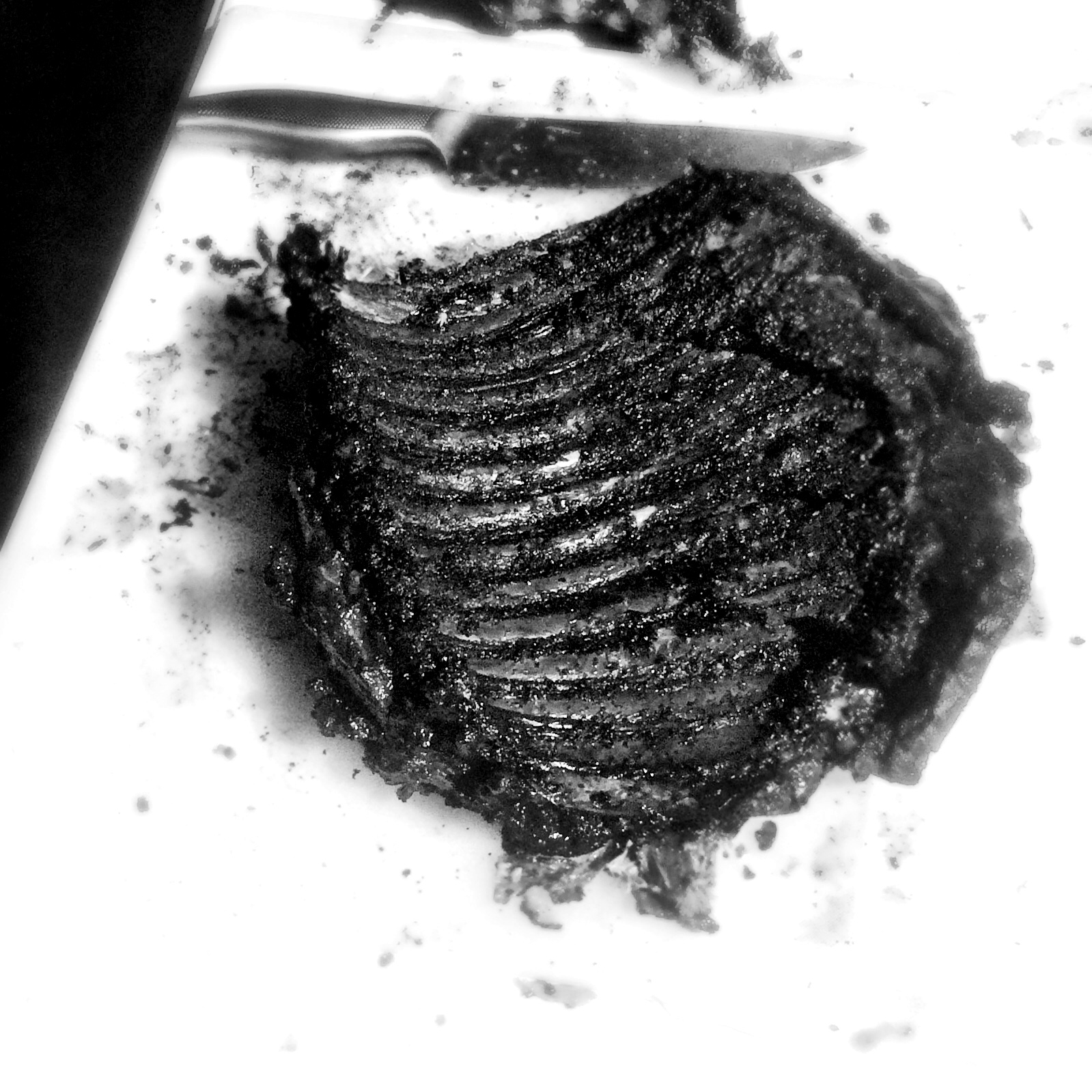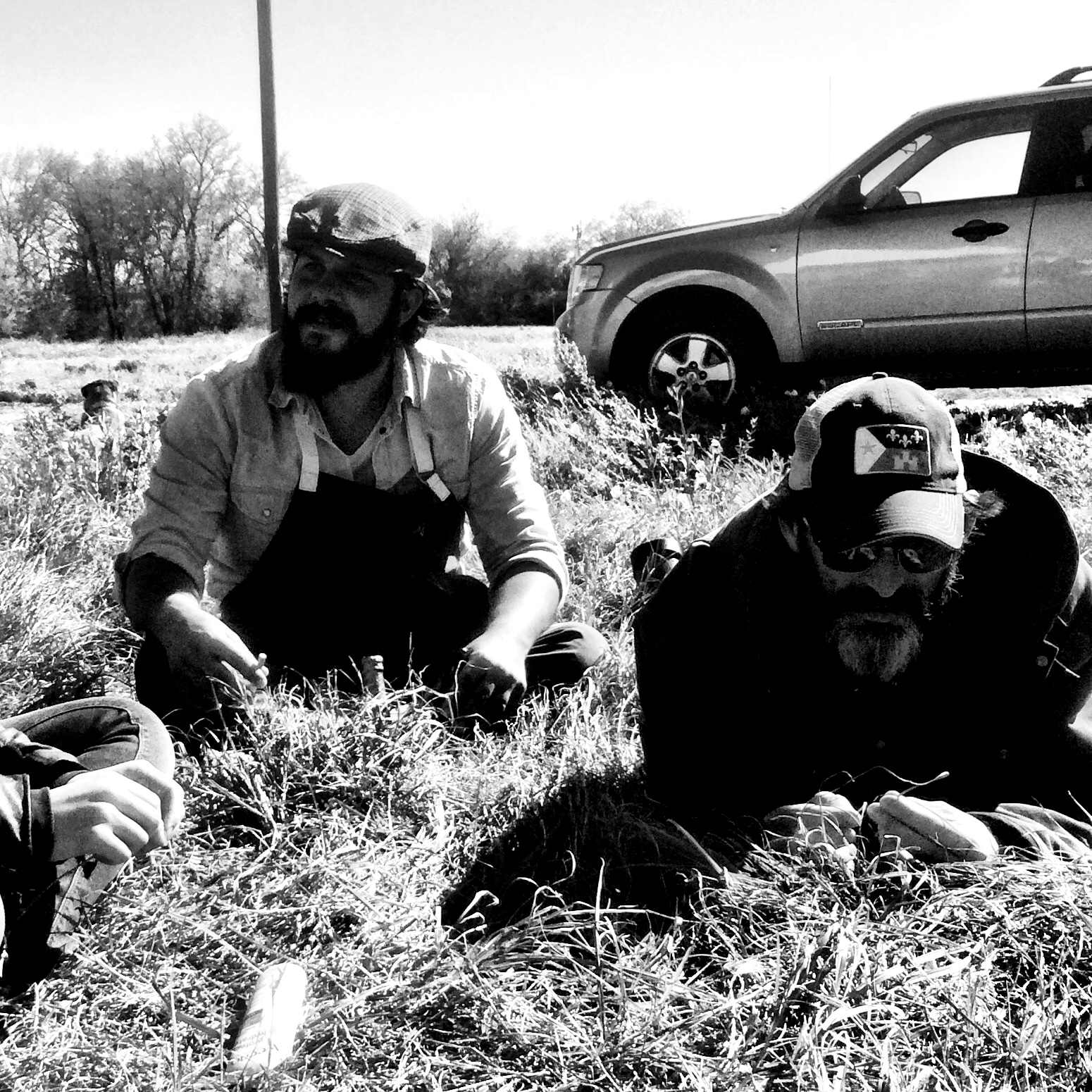At dawn on March 20, 2016, the rising sun splits the horizon between dark and light, revealing a suburban development of 5,000 square-foot McMansions—an unusual backdrop for a pig slaughter.
It’s the first day of spring and, after what has been a warm winter, even for Houston, it is surprisingly cold and windy. Fifty to sixty chefs, food and beverage professionals, and interested “civilians” are huddled in a field at the edge of the suburbs, a field that used to be a farm, field that will likely join its neighbor as a foundation for single-family homes.
For now, the field is dotted with a few tents, pickups, propane jet burners attached to white tanks, a livestock trailer housing a Meishan sow, and two tables. One is a stainless-steel commercial kitchen table with rusting legs on which a variety of knives, scissors, hatchets, and funnels are laid out with the precision of surgeon’s instruments. The other is handmade. The top is a large rectangular plank of plywood attached to a frame of two-by-sixes, three grapefruit-size holes evenly spaced down its center; four one-by-one wooden handles extending a foot or so from the ends of the platform; and four notches have been cut into the sides a few inches from the ends, which makes it easy to rest the tabletop on the two sawhorses that serve as the legs.
The wooden butchering table built by Toby Rodriguez.
The wooden butchering table was built by Toby Rodriguez, the visionary preservationist behind Lache Pas Boucherie et Cuisine, the roving butchering organization running this event. Rodriguez cuts a tall, gaunt figure. His playful yet serious eyes are framed by graying hair, a dark mustache, and a salt-n-pepper short-boxed beard. In his unbearded days, Rodriguez shared a passing resemblance to Townes Van Zandt and this morning he’s dressed a bit like a country-folk singer in jeans, a green Wrangler western shirt, a fleece-lined dark brown Carhartt jacket, and a trucker hat with the blue, red, yellow, and white Flag of Acadiana emblazoned across its brown front.
Thomas J. Arceneaux designed the flag in 1965. Arceneaux was the dean of the College of Agriculture at the University of Southwestern Louisiana (now the University of Louisiana at Lafayette) and a leader in the French Louisiana renaissance movement. Like Arceneaux, Rodriguez is trying to preserve Cajun culture, in particular the boucherie—the tradition of families helping each other slaughter and process hogs, ensuring that each week they all had enough to eat and that no part of the pig was wasted.
Toby Rodriguez
The sun is up and the crowd is standing in a loose half circle in front of the livestock trailer. Rodriguez, standing at the entrance of the trailer, quietly motions for everyone to backup. While one of his team picks tall grass from behind the trailer, Jim Gossen, the Louisiana native who helped organize this boucherie and co-founded Louisiana Foods, raises his hands chest high and says a prayer I can’t hear.
The folks gathered, even the chefs who spent much of the previous night drinking in this very field, are quiet. It’s a Sunday. This is church and there will be death. We feel it. We respect it and maybe even fear it. We watch in silent reverence. Maybe this is why so many religions once relied an animal sacrifice—it’s a reminder of how sacred life is, of the thin, viscous veil that separates the breathing from the non-breathing.
The wooden butchering platform has been placed at the entrance of the livestock trailer and Rodriguez is inside with the hog. He strokes her back. Calms her. Seems to feed her strands of long grass. It’s hard to see exactly what is happening in the dark trailer. But he wants the pig relaxed. She deserves that. She’s about to die and, for us the literal consumer, the meat of a pig stressed at death, like so many commodity pigs, isn’t as good. If she is to give up her life so we can eat, it should at least be good. Or so we tell ourselves as we quietly wait 5, 10, 15 minutes; it’s hard to say in this almost meditative state of anticipation. Then, at some moment that only Rodriguez divines, there’s a loud pop.
And all hell breaks out. The stunned pig is suddenly thrashing. Its muscles still instinctively reacting to the stimulus around it. Three to four guys are holding her down, massaging her belly and side. And then I noticed that in the chaos Rodriguez is no longer holding a pistol but a long, bloody knife. The pig’s throat has been slit and copious amounts of blood are pouring from the wound into a large mixing bowl. Chanel Gaudé, a cook from New Orleans, is pouring kosher salt into the blood and rapidly whisking it, ensuring it doesn’t coagulate.
After a few minutes, the pig goes still. She’s eased onto the butchering platform. Four men—pallbearers—grab the handles, lift, and carry her to the sawhorses.
Even though my dog was shot and killed on my fifth birthday, I was six when I first confronted the body of a dead animal. It was cold out and I was standing next to a cinderblock incinerator watching my 70-year-old maternal granddad peel the skin off a squirrel he’d shot earlier that day. If I remember right, and after 40-plus years that’s questionable, he put one boot on its tail and pulled the body up, leaving the fur behind and revealing, and this I remember clearly, the blue-veined, pinkish-red flesh.
That night he heated lard in a cast-iron skillet and fried squirrels. It did, at least to my childhood palate, taste like chicken.
Though I ate the squirrels and ducks he killed, I never hunted. But I fished, mostly with my paternal granddad. Mostly, for catfish. Spending lazy days baiting hooks with worms, grasshoppers, or stinky cheese and watching the bobber float on a lake or river. My paternal granddad taught me to be weary of the catfish’s spike-like fins, taught me to clip them, taught me to gut and skin the fish.
Once, when I was eight, I remember standing by a crab apple tree growing next to my granddad’s house on a hill. It must have been fall because my dad was there. We were cleaning the catfish we had caught earlier that day. My granddad sliced down a catfish’s belly, reached in, and pulled out the guts. He cut open the catfish’s enlarged stomach, revealing a fish head. Life eats life.
My daughter is ten. When she was three, she saw a pig head in her backyard; she saw a suckling pig butterflied and roasted. She has seen a pig roasted on a spit. She has watched me breakdown a 20-pound yellow-fin tuna and a 40-pound Warsaw grouper. She has helped me cut raw and cooked meat. She has buried her hands in the ground muscle and fat of a cow and made hamburger patties. But she has never seen an animal killed.
She once asked me if the animals we eat died, as she thought then, of natural causes. I explained to her no. I explained that we killed them. But I wonder if maybe that is a natural cause.
The thought of killing animals for food made her squeamish. And it should, or at least, should give pause. Eating meat is brutal. But not in the modern sense of that word: “grossly ruthless or unfeeling; cruel, cold-blooded;” but its archaic meaning: “typical of animals.”
I can’t think of a single word to accurately describe watching Rodriguez straddle a just-killed hog and use a large knife to cut the pig from its throat to its sternum; watching the pig’s flesh flop open exposing thick layers of white fat and reddish meat; watching him reach for a mallet-like hatchet and hammer hard to crack and split the ribs; watching him eviscerate the pig, pulling out the sack that holds the internal organs and bloody intestines.
Words like "brutal" and "violent" come to mind. But our modern definitions of those words imply something evil and wrong about the actions they describe. But this is no more evil than a lion taking down an antelope and then tearing through its flesh or a grizzly eating a live salmon or a red-tailed hawk swooping down and burying its talons in a field mouse’s flesh.
But those animals are acting on the instinct to survive. We are making a choice.
In the winter of 1991, I chose to be a vegetarian (though while living in D.C. in close proximity to the Chesapeake Bay, I couldn’t resist crab cakes, which I ate weekly at the Hamburger Hamlet—and, yes, I see the irony).
I chose not to eat meat for a few reasons: growing concerns about how animals were being treated by factory farming; ethical questions about killing animals; and, in retrospect, to rebel against what I perceived at the time as my small-minded, rural upbringing—cattle and hog money helped put me through school, so fuck cattle and hogs. I eat meat now.
The four pallbearers carry the tabletop and hog fifty feet or so and lower them both onto the sawhorses. Rodriguez’s cohorts lay steaming-hot burlap bags over the pig and then start pouring pots of boiling water over her, scalding the skin, loosening the hog’s bristle-like hairs.
Men and women gather around the warm hog and with bare hands and dull knives scrape off the hairs that have been loosened by the scald.
Scalding the skin with hot burlap bags and boiling water
The night before lots were drawn and now, from a black perfect-bound notebook resting by the pig’s head, Rodriguez reads each chef’s assignment: smokehouse, boudin, backbone stew, fraisseurs, headcheese, graton. Then the butchering begins.
At what point, do we stop calling the hog “her”? At what point, does she become no longer a “hog” or a “sow” or a “pig” but “pork”?
Since 1909, the United State’s per capita pork consumption has, with the exception of a big drop during World War Two, remained fairly steady, ranging from between 40 and 50 pounds per person per year. By comparison, beef and chicken consumption have increased dramatically. We have gone from eating 10 pounds of chicken a year to 70 pounds.
According to the North American Meat Institute, an industry trade association, the United States in 2013 processed 112 million hogs and produced 23.2 billion pounds of pork.
““In community boucheries, eight to twelve families—sometimes as many as twenty—banded together, each pledging to provide, on a rotating basis, a calf or a hog for slaughter. The order in which the donations were made was determined by lot. The type of animal slaughtered varied with the seasons—calves in spring, summer, and early fall, hogs in late fall and winter … According to [sociologist Steve L.] Del Soto, ‘This [system of seasonal rotation] takes advantage of the fact that cattle are generally fatter during the spring and summer months, while hogs are poorer. The reverse is true for the fall and winter—hogs are fattest and cattle are poorest.’ By varying the meat variety, members of the boucherie collective assured that these agrarian cooperatives would have a steady variety of quality meat throughout the year.” ”
I don’t how my paternal grandfather’s family slaughtered and butchered the hogs they raised on his family’s farm in rural Missouri when he was a kid in the early 1900s. But given the stories my mom told about her parents knowing how to slaughter chickens, the smokehouse on my granddad’s place in town, and history, I’m guessing they slaughtered and butchered them in ways similar to the method's Rodriguez uses, though I think it was more a family affair than a community event.
By the time I was living with my paternal granddad in the early 1970s, he‘d stopped butchering the livestock he raised. Every year, he would have a hog and a side of beef butchered at Brown’s Processing. We’d always have a freezer full of meat he raised.
He still cured the hams, which hung in a dark, un-climate-controled room off his garage and which we ate every Thanksgiving and Christmas; made his own bacon, which I ate cold from a plate he left me in the center of the kitchen table every morning; and ground his own sausage, which he formed into patties, parcooked, packed in lard in Mason jars, and stored in the basement.
After 12 years and a brief, misguided flirtation with veganism, I stopped calling myself a vegetarian. I had started eating fish, usually at restaurants once a week or so, a few years earlier, though I still thought of myself primarily as a vegetarian. This was in days before terms like “pescatarian” and the redundant “flexitarian” (we already have a word for that—omnivore) were in vogue.
There was no epiphany, no deep philosophical considerations that lead me to bite into the iconic cheeseburger at Houston’s Lankford Grocery—my first bite of land-raised meat in 12 years—only a boredom with my diet, a curiosity about cooking meat, and thinking it was ridiculous and hypocritical to call myself vegetarian when a fish was clearly not a vegetable but a living, breathing animal. Though my ongoing concerns about factory farming and my own ties to and nostalgia for family farming have guided me toward seeking out the increasing number of local farmers raising their animals humanely and ethically.
1964 Elsberry Democrat ad for Galloway Brothers, the grain elevator and agriculture supply business my granddad and great uncle owned and operated.
I often wonder if my granddad raised his livestock in way I would now consider ethical. Livestock was a small part of his farming operations—he had maybe a 100 to 150 head of cattle and 50 to 100 hogs scattered across two or three farms—a way to use the land in the hills that was too rocky and steep for cultivation. His primary focus was the 100s of acres of rich, fertile Mississippi River bottomland where he raised corn, soy, and wheat, much of which I realize now went to feed hogs and cattle.
His cattle roamed free to eat grass and in winter their diet was supplemented with hay and commercial grain-based feeds. I don’t know how he finished his cattle. I was too young and took it all too much for granted to ask questions. Though I suspect like other cattle of that time they were sent to larger feedlots and slaughterhouses like those in Kansas City.
His hogs lived in large fenced-in areas with smaller pens and corrugated-tin Quonset huts to shelter and segregate the sows with piglets. They were fed, from the best of my knowledge, corn, the commercial hog feeds available in the 1970s and 80s, and the occasional kitchen scraps.
His farms were not the concentrated animal feeding operations (CAFOs) that have come to define factory farming. But he was, like most farmers, also a businessman concerned with things like yield per acre, dressing yield, and the price of pork belly futures. He would have used (and sold when he also ran a grain elevator that sold agricultural supplies) the latest commercial animal feeds with the latest supplements, which had been added to livestock feeds since 1920s, when fish meal and cod liver oil were added to the diets of chickens and hogs so they would gain weight faster, helping farmers keep up with urban demands for meat.
In the 1950s, B12 and small doses of antibiotics began to be added to the diet of cows, hogs, and chickens. Research in the late 1940s and early 1950s showed that feeding animals these supplements increased their growth rates by 50%. With continued increases in demand from both a war-torn Europe and an increasingly urban population that no longer farmed yet encroached on farmlands, farmers were quick to adopt these new methods. No matter what I may think of these practices now, I can’t blame farmers for employing them to help meet demand. I’m pretty sure my granddad—a practical, hardnosed, Midwestern farmer—used them.
But I don’t know for sure. By the time I was in 8th grade and my mom and I were living in our own place, I was too interested in racking up points on Asteroids on my Atari 2600 than in talking to my granddad about farming. Thus, continued my slow and unfortunate disconnect from my rural farm- and foodways—a disconnection that, mind you, started before I was born. A connection I’ve been spending the last few years trying to repair, or more accurately, recreate.
scroll through
Rodriguez has successfully removed the intestines, stomach, and the hog’s internal organs. They are lying in a bloody, lumpy pile at the tail end of the hog. He prefers butchering the hog while it lies flat on a table instead of hanging from its hind feet. According to Rodriguez, it protects the meat from the fecal matter still in the intestines.
Using a sharp knife, he starts to gently remove the voile—what Cajuns call the caul fat because the network of fat, blood and lymphatic vessels, glands, and nerves that helps connect and nourish the pigs internal organs resembles a delicate wedding veil.
When he’s done, he unrolls and holds up the voile for all to see—a scroll in an ancient, unreadable language commanding reverence from all those about to partake. He lowers it into an aluminum container of water and hollers “smokehouse.”
Toby Rodriguez holding up the voile—what Cajuns call the caul fat.
Barrett “Dupe” Dupuis, a member of Rodriguez’s team, wraps the voile around sausage ground from other bits of the hog—saucisse de voile. When he is done, he ties it off with butcher’s twine. Then he stuffs the stomach lining with sausage and sews it shut—chaudin. Both will join ribs and one of the hams in the smoker.
A few hours later, a little after midday, we eat our first meal: backbone stew, the meat from the backbone slowly cooked in a dark brown roux; fraisseurs, a deep, stew-like dish made from tongue, cheek, organ meats, and the liver cooked down to a roux-like gravy—a recipe that was almost lost until Rodriguez recovered and compiled the unwritten recipes from three old-timers, a dish Rodriguez says must be cooked in a cast-iron kettle—rice, this is Cajun food so there is always rice; and black eyed peas cooked in “leaf lard rendered in leaf lard.”
Later in the afternoon, Dupuis pulls the saucisse de voile from the smoker. It’s deep golden brown with flakes of licorice-black bark. He cuts the string, slices the sausage with a cleaver. And we eat the well-seasoned ground meat and the web that just hours before nourished the hog’s bowels.
Barrett “Dupe” Dupuis slicing the saucisse de voile.
Related content: Best Meat On the Bone








